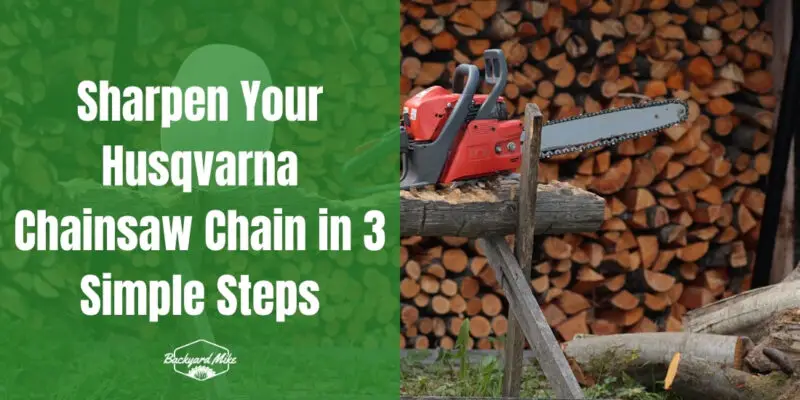To sharpen your Husqvarna chainsaw chain effectively, begin by gathering your tools like round files, file gauge, and a sturdy vise. Keep your workspace organized with good lighting, and use safety gear. Select a round file matching your chain's specifications, maintaining a 25 to 30-degree angle while filing. Use consistent strokes for even sharpening. Finally, fine-tune the depth gauges with a suitable tool for consistent depth across the chain. Discover more steps to optimize your chainsaw's performance.
Key Takeaways
- Select the correct round file size for your Husqvarna chainsaw chain specifications.
- Maintain a consistent 25 to 30-degree angle when filing each cutter.
- Use smooth, even strokes to sharpen each cutter for uniform sharpness.
- Check and adjust the depth gauges using an appropriate depth gauge tool.
- Regularly inspect and maintain your tools for optimal sharpening performance.
Gather Your Tools and Prepare Your Work Area
Before you start sharpening your Husqvarna chainsaw chain, it's essential to gather the right tools and prepare your work area properly.
Begin with tool selection; make certain you have round files, flat files, a file gauge, and a stump vise. These are vital for a precise sharpening job. Match your files to the chain specifications for the best results.
Ensure you have the right files and stump vise for precise chain sharpening.
Organize your workspace by securing a sturdy work surface, making sure of proper lighting, and wearing safety equipment like gloves and safety glasses. Inspect the chain for any damage before you proceed. Husqvarna chainsaws are designed to be among the quietest options available, making them more comfortable to use during extended work sessions.
Clear your area of obstacles, and use anchor points such as stumps to secure the stump vise. Frequent sharpening ensures better precision and is easier to maintain with regular, small adjustments. Organizing your tools efficiently will streamline the process, guaranteeing you're ready to sharpen confidently.
Master the Art of Filing With a Round File
Once you've set up your workspace and gathered your tools, it's time to focus on mastering the art of filing with a round file.
Start by selecting the correct file size for your chain—common diameters include 3/16, 5/32, or 7/32 inch. Verify your file is sharp; dull files make sharpening inefficient. Position about 20% of the file above the tooth, maintaining a 25 to 30-degree angle. Use smooth, consistent strokes to achieve even sharpness. Keeping saws sharp not only saves time but also improves the overall efficiency and performance of the tool. A good practice is to align the file accurately with angle markings if available, ensuring optimal sharpening results.
- File Selection: Choose the right size for your chain type.
- Filing Techniques: Focus on angles and smoothness.
- Sharpness Importance: Keep files sharp for effective filing.
- Storage: Store files properly to prevent dulling.
- Consistency: Verify all teeth are sharpened evenly.
Fine-Tune the Depth Gauges for Optimal Performance
Fine-tuning the depth gauges on your Husqvarna chainsaw is essential for maintaining peak performance and safety. Depth gauge adjustments guarantee your chain cuts the right amount of wood, enhancing efficiency. Begin by selecting the appropriate depth gauge tool for your chain size—whether it's .325", 3/8", or .404". Use this tool to guide your filing techniques, guaranteeing consistent depth across the chain. Husqvarna's tools are designed for use with their flat files, ensuring compatibility and optimal results. Secure the tool firmly against the chain and employ a flat file to achieve the precise gauge height. Adjust settings based on the wood type, as hard and soft woods require different clearances. Take your time to avoid over- or under-filing, which can impact performance. Regular maintenance of depth gauges prevents dull performance and guarantees ideal cutting.
Frequently Asked Questions
How Often Should I Replace My Chainsaw Chain?
You should replace your chainsaw chain when you notice replacement indicators like visual damage or performance issues. Chain lifespan varies, but regular inspection helps. Trust your instincts and join others who prioritize safety and efficiency in their tools.
Can I Sharpen a Chain That Has Hit a Nail?
Picture the chain as a warrior's sword; nail damage is a battle scar. You can sharpen it for better chain maintenance, but inspect thoroughly. If damage runs deep, consider joining fellow enthusiasts in replacing it for safety.
What Signs Indicate That a Chain Needs Replacement Instead of Sharpening?
You notice chain wear when excessive oil consumption, frequent tension adjustments, and dull cutting persist. Replacement indicators include broken teeth, worn cutters, and significant drive link wear. Prioritize safety and performance by joining those who choose timely replacements.
Are There Different Sharpening Techniques for Different Chain Types?
You've got different sharpening techniques for various chain types. Hand filing offers precision, machine grinding delivers speed. Round files suit round ground chains; flat files refine depth gauges. Embrace your community's wisdom and keep your chainsaw sharp.
How Do I Know if My Chain Is Tensioned Correctly After Sharpening?
To guarantee proper chain tension after sharpening, check that the chain moves freely without sagging. Perform a manual test, guaranteeing smooth engagement. Proper adjustment creates a sense of safety and belonging in your chainsaw community.
Conclusion
Think of your Husqvarna chainsaw chain as a knight's sword—sharpness is its strength. By gathering your tools, mastering the art of filing, and fine-tuning the depth gauges, you're ensuring your sword is always ready for battle. With each step, you're honing its ability to cut through challenges with ease. Remember, maintaining your chainsaw's sharpness is key to its performance. Follow these steps diligently, and your chainsaw will serve you faithfully, ready for any task.


